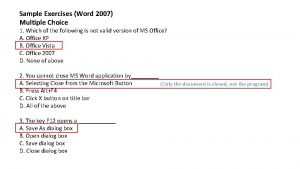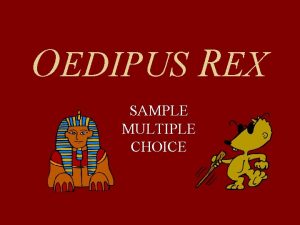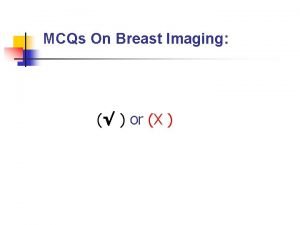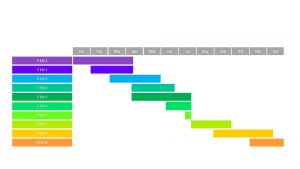Item Analysis Multiple Choice Questions What makes a















- Slides: 15

Item Analysis

Multiple Choice Questions What makes a good question? ? ?

How can we determine if it is a good question? ? ? Distractor power n Item difficulty n Item discrimination n

Distractor power Strength of each distractor (should be equal) # answering incorrect # of distractors

E. G. Option a is correct n if 9 people choose option b (9/3 = 3) n and 12 people choose option c (12/3 = 4) n and 15 people choose option d (15/3 = 5) n then option d is the strongest distractor n

Item Difficulty = p (percent of people passing) P = number answering correctly total number answering n If 100 people take the test and 34 get question 1 correct, what is the difficulty of that question? P 1 = 34/100 =. 34 n For 65 correct p would be 65/100 =. 65 SO… the higher the p, the easier the question (score must be between 0 and 1)

Item Difficulty is. . . A behavioral measure n Based on the current group n Allows external comparison n

Item discrimination = d Does the question discriminate between those who do well overall and those who do poorly?

Distribution To determine level upper (U) = top 25 to 33 % of scores lower (L) = bottom 25 to 33 % of scores

Determining item discrimination d = U-L n where d = item discrimination U = upper group who pass L = lower group who pass n = number in one group (U or L)

Value of d Range for d = -1 to 1 n higher d indicates more discriminating (1 = all in upper group got it correct and none in lower group) n negative d indicates a really bad question (1 indicates all in lower group got it correct and none in upper group) n

Examples of d With 33 in U and L n if all in U get it correct, and none in L 33 - 0 / 33 = 1 n if none in U get it correct, and all in U 0 - 33 / 33 = -1 n if all in U and all in L get it correct 33 - 33 / 33 = 0 n if 30 in U and 10 in L get it correct 30 - 10 / 33 =. 61 n

Chapter 7 Test Development process – p 191 test conceptualization test construction test tryout analysis revision

Answer types (table 7 -1) Likert scale (rating scale) n Forced choice (paired comparisons) n Matching n True/false n Multiple choice n Open ended n

 Multiple choice questions on poetic devices
Multiple choice questions on poetic devices How to write multiple choice questions
How to write multiple choice questions Merchant of venice act 4 scene 1
Merchant of venice act 4 scene 1 Exam on the story of an hour quiz
Exam on the story of an hour quiz Stimulus based multiple choice questions
Stimulus based multiple choice questions Which conjunctive adverb best completes the sentence
Which conjunctive adverb best completes the sentence Exercises for microsoft word
Exercises for microsoft word Stimulus-based questions examples
Stimulus-based questions examples Astronomy questions and answers multiple choice
Astronomy questions and answers multiple choice What is the purpose of persuasive writing mcq
What is the purpose of persuasive writing mcq Oedipus multiple choice questions
Oedipus multiple choice questions Multiple choice questions on shakespeare sonnets
Multiple choice questions on shakespeare sonnets Mitosis
Mitosis Mcqs on breast anatomy
Mcqs on breast anatomy Growth mindset multiple choice questions
Growth mindset multiple choice questions Biomes multiple choice questions with answers
Biomes multiple choice questions with answers




























